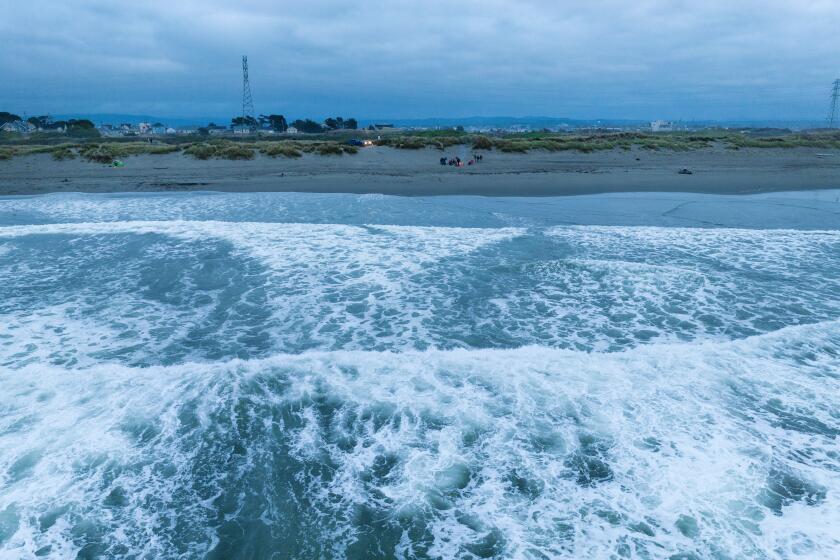A dying girl, a fateful blessing and the lessons of California’s tragic origin myth
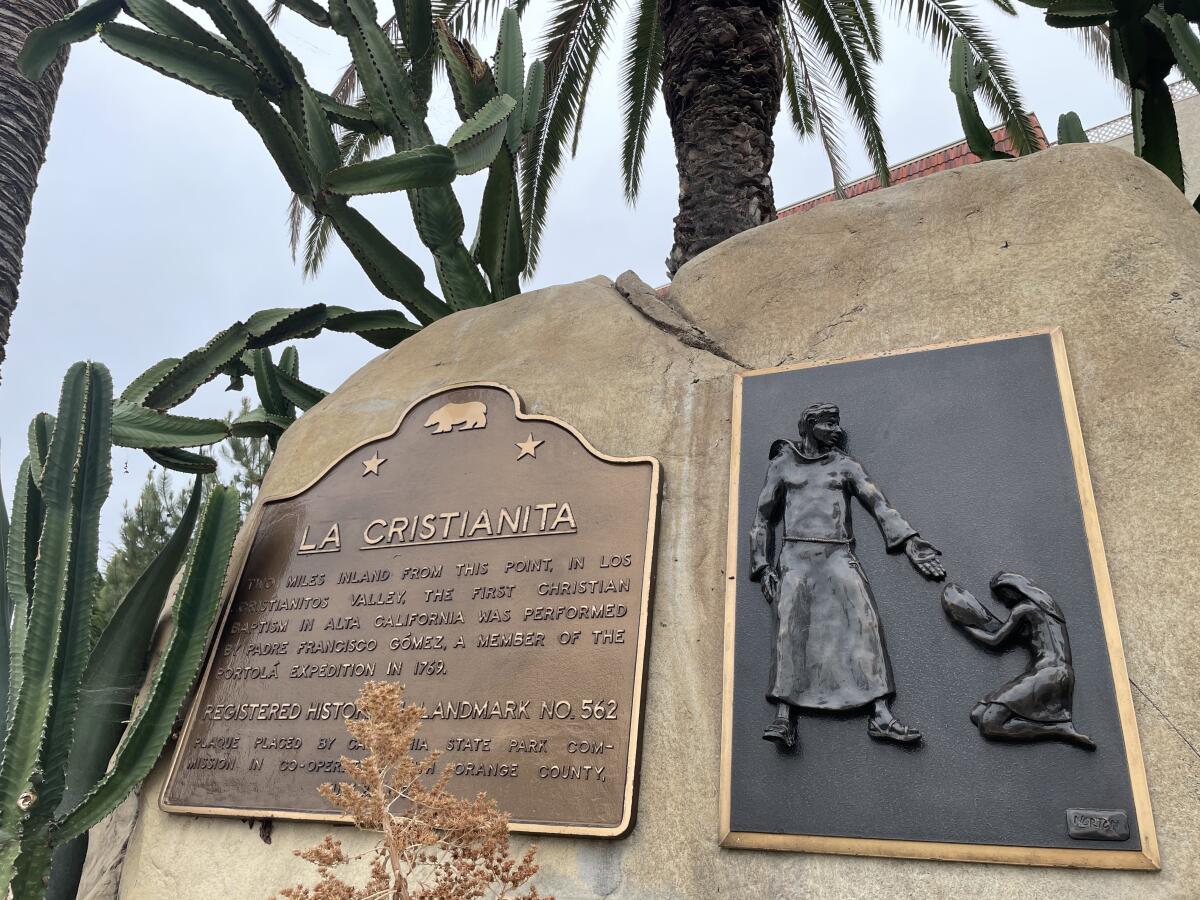
- Share via
CAMP PENDLETON — One weekday morning last month, I went down to Camp Pendleton with a mission: Find California’s forgotten Fountain of Youth.
Specifically, I was in search of State Historical Landmark No. 562, also known as La Cristianita — the Little Christian Girl. There, in the northwest corner of the base, is a plaque that commemorates the 1769 baptism of a dying Native American infant girl by missionaries.
It was the first christening in what is now California.
La Cristianita was celebrated as a foundational moment in our history for generations, a metaphor for the myth that Europeans transformed this land from wilderness into Eden. California’s earliest chroniclers in Spanish and English breathlessly recounted the incident. Newspapers — including this one — wrote stories about quests to find the original La Cristianita spot, which seemed to change location every couple of years.
White actors reenacted the baptism for decades: near the historic site itself, in the nearby city of San Clemente, in plays across Southern California and even on floats in everything from Veterans Day marches to the 1957 Tournament of Roses Parade. These events served to replenish our self-conception of a California where the eternal good life was possible for anyone, if only they truly believed.
Nowadays, though, the La Cristianita saga and its monument are barely remembered — even by their putative caretakers at Camp Pendleton, as I soon discovered.
The day before my visit, demographers reported that 2020 saw California lose residents for the first time ever. We’re still the largest state in the U.S. by far, an economic and political powerhouse despite the ravages of the COVID-19 pandemic — but the population report provoked chatter about the death of the California Dream on my text threads, on my Facebook page and beyond.
I’ve long scoffed at reports of our demise. But the problems that beset too many of us are real. Housing instability. Climate change. Endless drought. Economic inequity. A disease that’s slowly wiping out our beloved citrus trees.
Are we facing the end of California as a dream? As the dream?
I needed a place to consider our troubles but also, I hoped, to identify a way forward by looking at our past.
The place was La Cristianita. But first, I needed to get there.
On this fact-finding journey, Lance Cpl. Andrew Cortez would be my attaché for the day. We met at the San Onofre gate just off the 5 Freeway, where he set the rules of engagement for my pilgrimage: Follow him at all times. No comments on the record. Otherwise, let’s go.
In separate SUVs, we drove through Camp Pendleton in what seemed like a Marvel Cinematic Universe trip through quantum realms. Suburban tract homes led to Vietnam-era barracks anchored by officer headquarters that dated to World War II. The landscape shifted from native trees to fields covered in mustard flowers, the bright yellow invasive plant that Junipero Serra and his fellow Franciscans supposedly sowed to serve as signposts as they traveled the route of the California missions.
Deeper and deeper we drove — too deep, actually. Because half an hour later, Cortez suddenly exited Camp Pendleton and entered San Clemente. He eventually parked next to a golf course ringed by whitewashed apartments built in the Spanish Revival style.
We were lost. His superior gave him the wrong GPS coordinates. Did I know how to get to La Cristianita?
**
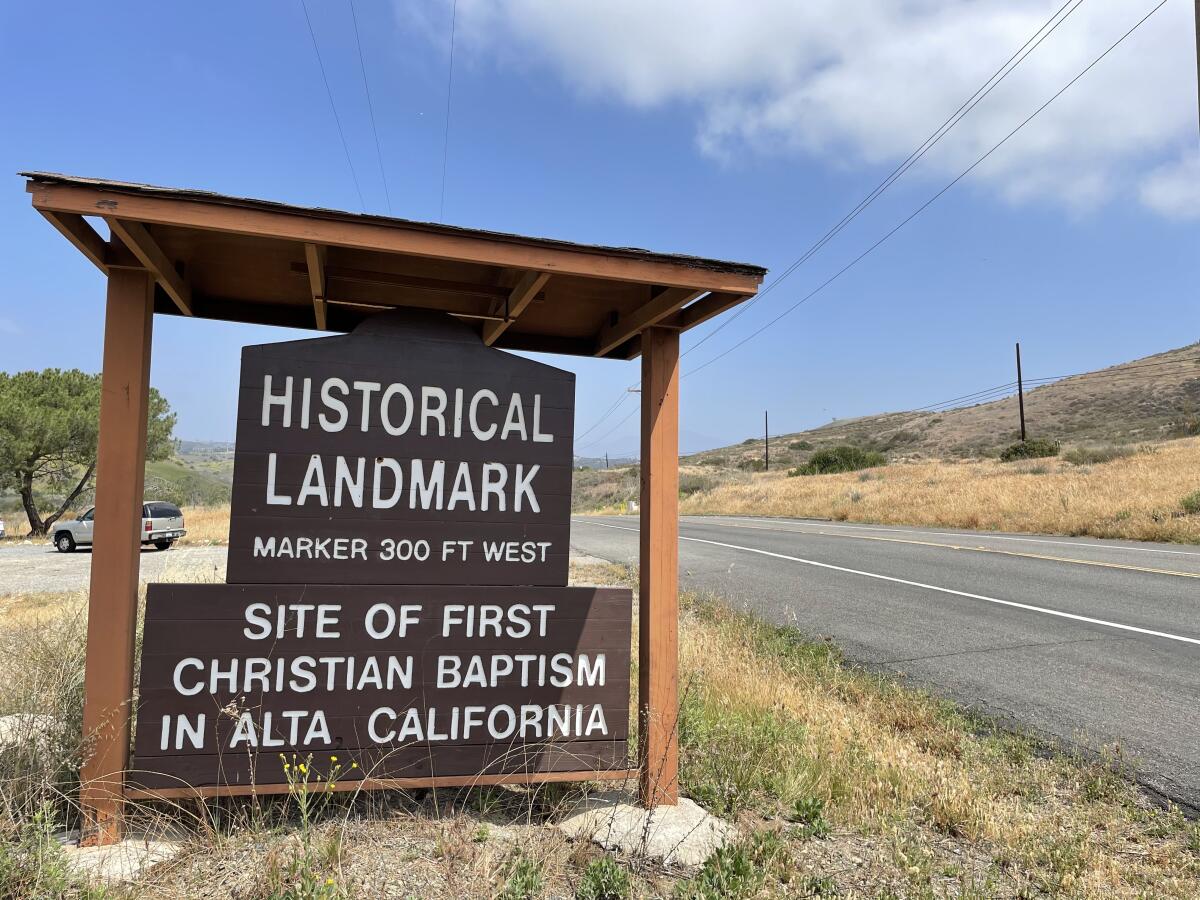
Soon after demographers reported their grim findings about California’s population shrinkage, newspapers offered autopsies. Talk-show and podcast hosts fulminated against Democrats, whom they blamed for driving away so many people with their liberal policies. Californians, already battered by the hell of 2020, hung our collective head in a way we never had before.
No longer does the world see us as the Promised Land. Now, Californians are fleeing for states long considered pretenders to our Golden State exceptionalism — that’s all you, Texas.
As Cortez texted his boss for new coordinates, I recounted a quick version of California’s original baptism, where the idea of the California Dream truly began.
In the summer of 1769, an Acjachemen village on what’s now the border between Orange and San Diego counties welcomed the Gaspar de Portolá expedition. The conquistadors — about 63 strong, with two Franciscans — were the first Europeans to explore the region, tasked with finding suitable plots for Catholic missions and Spanish settlements. They could’ve slaughtered the Acjachemen villagers, as so many of their contemporaries did in similar circumstances across the Americas.
But there was no bloodshed. In this initial encounter, Father Francisco Gomez and Father Juan Crespí sought to save souls for Christ. Gomez baptized a sick infant whose true name is unknown with the new moniker Maria Magdalena — Mary Magdalene. Crespí followed up with another dying girl he called Margarita. “God take both of them into heaven,” the latter wrote in his diary, which remains the definitive account of the Portolá expedition.
Cortez had never heard this tale. Maybe it was for the better.
La Cristianita’s story set the unconscious template for how Californians treated and considered the state and especially people of color for more than two centuries — not as communities with agency, but wretches in need of salvation. It was little surprise, then, that the legend crumbled into historical shards as California diversified. The reenactments ended; the plays gathered dust in the archives of local historical societies. Faye Jonason, Camp Pendleton’s history and museum director since 1996, wrote via email that civilian requests for tours to La Cristianita now average only three a year.
It’s not a legend of Old California worth resurrecting, I felt. But I needed to see the La Cristianita tribute myself before dismissing it completely.
After a short break, Cortez and I discovered the directions we needed (thanks, Google). The way there was up the aptly named Cristianitos Road, which led back into Camp Pendleton.
Instead of a half-hour journey, the drive now took only minutes. The road turned into hills, turned into a bluff. Soon, we came across a large wooden sign that announced we had arrived at La Cristianita.
Sycamore trees towered over benches. A large white cross overlooked Cristianitos Canyon. The Pacific Ocean shimmered in the distance. A massive gravel lot hinted at the spot’s popularity in the past.
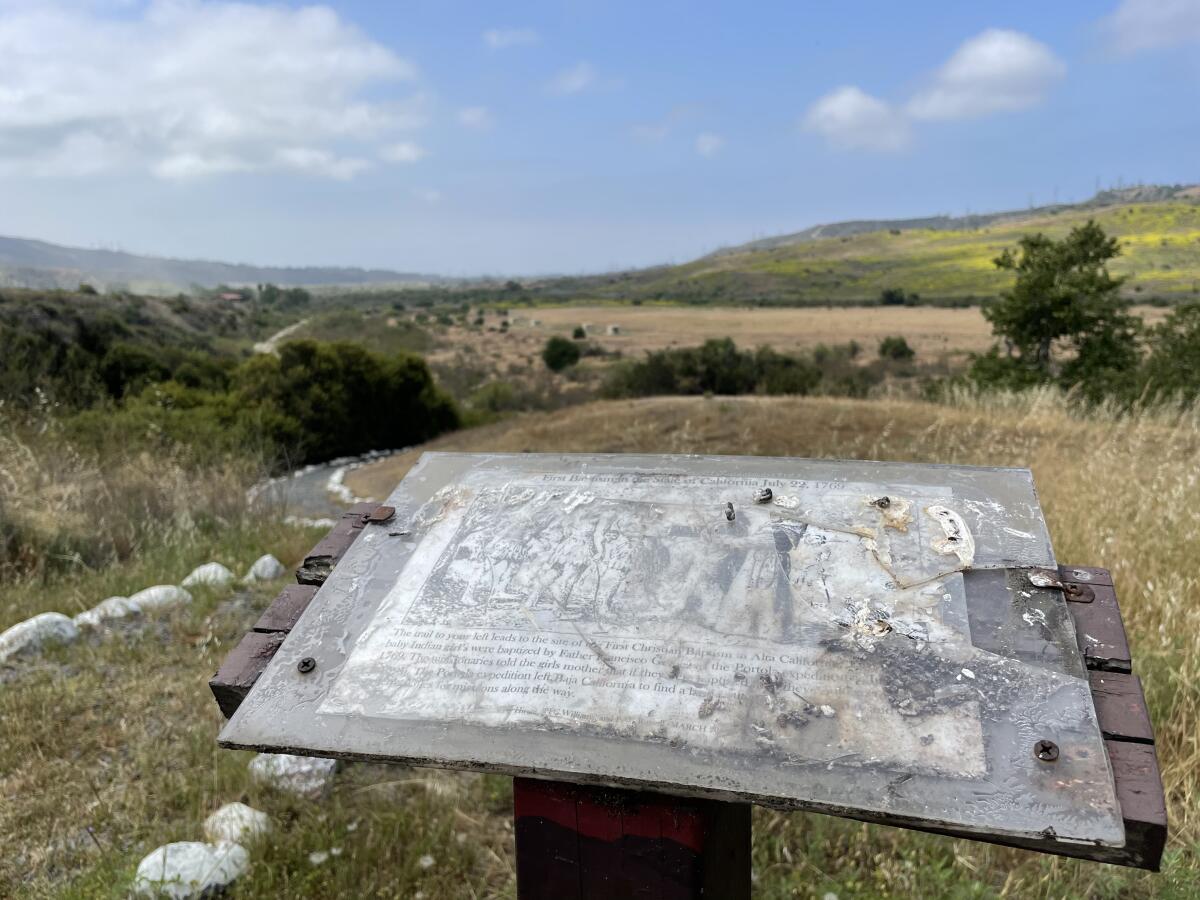
At the start of a trail marked with white stones was a printout with a drawing that imagined how the La Cristianita baptism looked like. A short caption detailed the history, but I could barely read it: the display was behind shattered plexiglass soiled with grime and bird droppings.
I did make out the sentence that stated the trail before us led to the La Cristianita monument. Cortez and I hiked a couple of minutes down to an oasis of oaks, native shrubs and flowers that blossomed from the side of the canyon. Hummingbirds buzzed around as critters scampered in the underbrush. The faraway sound of the weed whackers and leaf blowers I saw Marines using minutes earlier to remove mustard flowers was the only hint of any other human activity.
It was as pristine and precious a place as any I’ve seen in California.
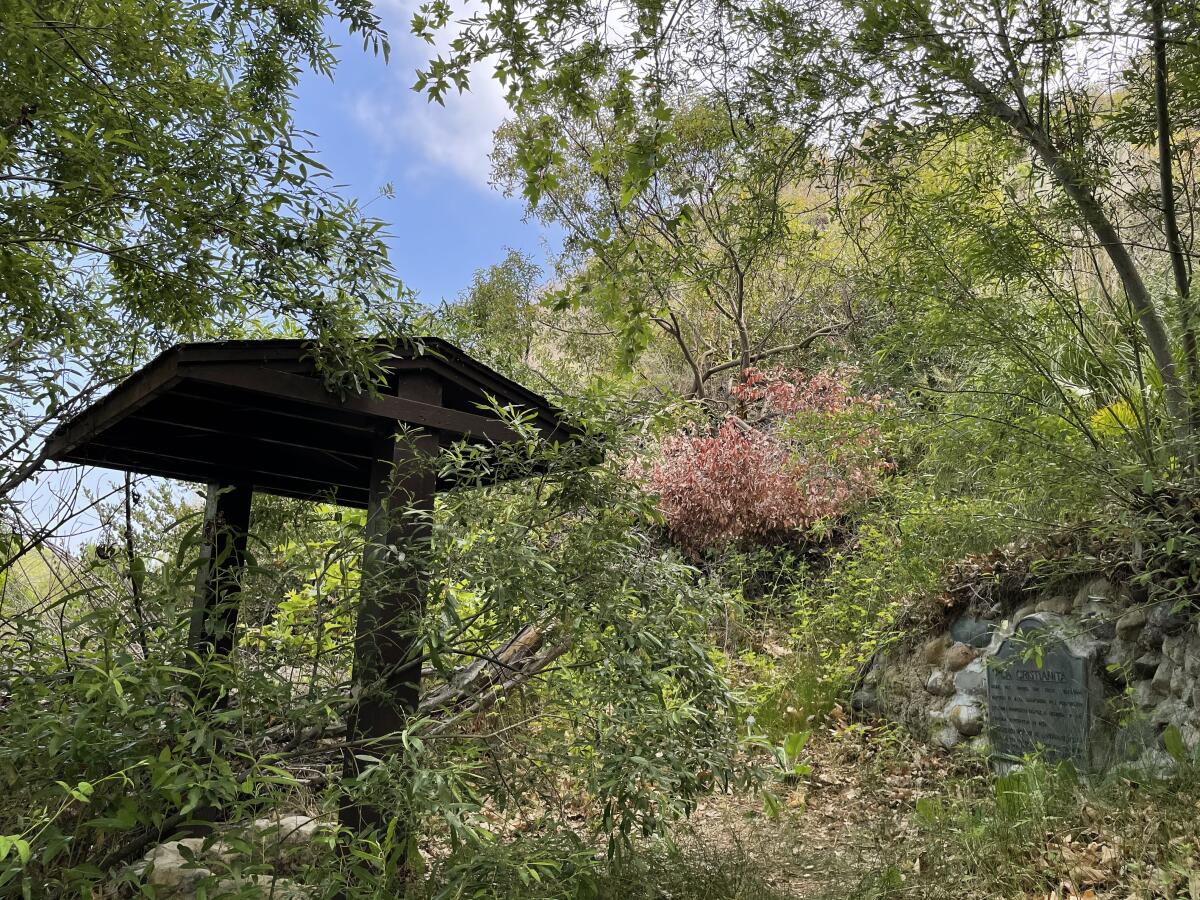
The shrine itself is simple: a replica baptismal font covered by a well house. A fallen palm tree lay to the side. Before this humble scene was a small rock wall with a bolted-on bronze plaque declaring that Father Gomez performed his baptism “near this spring.”
It had a date I didn’t expect: 1957. I thought La Cristianita was erected by the Catholic Church, or maybe the Spanish crown, or even the earliest American settlers.
Nope: A quick online search revealed its sponsor was the San Clemente Chamber of Commerce, which at the time also put up a similar plaque along El Camino Real as a tourist trap. It’s now in front of the Casa Romantica Cultural Center and Gardens, along with another plaque depicting a cowering Native American woman offering La Cristianita to a grim padre.
Cortez left me with my thoughts for a couple of minutes before we departed. The easy traipse down proved to be a steep hike back up. The cool breezes I had felt just moments before turned hot. I bade farewell to my guide, then drove back home.
As I traveled up the 5, the fake-Spanish street names of South Orange County flashing before me, I tried to make sense of what I had just seen. But I was distracted: Burrs from my hike had worked their way into my socks.
I let them scratch up my leg until I reached home. As I removed the small, spiked orbs, the true meaning of La Cristianita suddenly became clear.
The retellings of her baptism that made it into the newspapers and history books make it seem as if La Cristianita’s mother consented to the act. They never reveal that it wasn’t the case, something Crespí freely admitted in his diary.
“The mother would not in any way let us see” her child, he wrote. Father Francisco Gomez nevertheless washed the baby’s head with water “as well as he could with her clutched to her mother’s breast.”
Months later, the Portolá expedition returned to the same Acjachemen village on their way back from San Francisco Bay. Crespí remembered it as where they had baptized La Cristianita, but didn’t note if he inquired about her fate. The girl, after all, mattered more to him dead than alive.
“I have no doubt,” Crespí wrote, “that in passing by we have won this soul’s passage into Heaven.”
As California moves toward an uncertain future, we need to learn from the death of the Indigenous infant we remember as La Cristianita, not her baptism. We can’t treat the state anymore the way Crespí and nearly everyone else who followed him used the martyred girl — as a plaything on which to live out our dreams, with no care for who gets in the way.
Instead, we need to listen to the state, to ourselves. We’re sick. We need healing, not promises of a sweet hereafter. We are all La Cristianita now.
More to Read
Sign up for Essential California
The most important California stories and recommendations in your inbox every morning.
You may occasionally receive promotional content from the Los Angeles Times.








